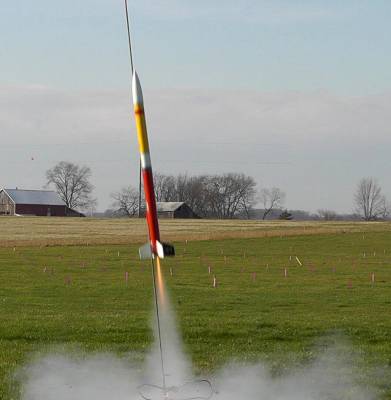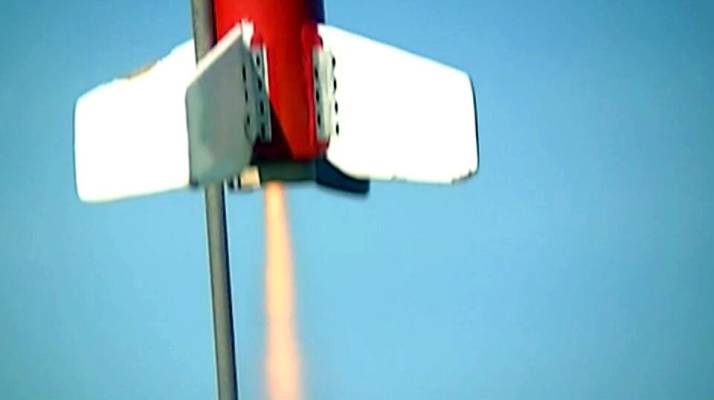The Aero-Hi: This is a cute little flier from Estes using 13mm T engines. It is a pseudo-scale sounding rocket design. This normally uses a tiny 8-inch parachute but was converted to a streamer for a bit, then later converted back into a parachute recovery which I find easier to pack. I actually have two of these, one painted green and this one red. One unique feature of this kit is the simulated conduit up the side of the body tube, made from a balsa strip.
This rocket was later given my "Iris" modification, which extends the body tube about 5 inches above the streamer/parachute bay, and allows for a payload with an Altimeter One or Two to measure altitudes. It's a shame I "ruined" it by adding the payload, she was a cute little bird. (I can always remove the payload.) I like to send this, or the EAC Viper rocket up first on launch days, it's a good and economical way to get an idea how the winds are blowing without risking a lost rocket. As a result, this has flown many times. (Iris is named after the Greek god of the rainbow. She is a messenger of the gods, linking the gods with humanity.) This rocket has flown as high as 282 feet with the A motor, which is higher than the Cape Hatteras Lighthouse in NC, the tallest lighthouse in the USA.
| Flight Date: | 2012-11-23 |
| Rocket Name: | Aero-Hi |
| Kit Name: | Estes - Aero-Hi {Kit} (817) [1973-1974] |
| Flyer's Name: | Rich DeAngelis |
| Motors: | A3-4 |
| Expected Altitude: | 265 Feet |
| Wind Speed: | 9.00 mph |
| Launch Site: | Penn Manor School Lancaster PA |
| Actual Altitude: | 221 Feet |
It was getting very windy, but the Aero-Hi Iris is not bothered too much by wind and doesn’t go too high, so I chose this rocket to end the day of flying. Again I was going to compare the A3 and A10 motors to measure the difference. For these flights, the streamer was changed out for a 10” parachute. Note that this is the original parachute supplied with the Estes kit, one of the few survivors over the years.
I fired up the A3 first, and it burned for 8/10 seconds, accelerating off the pad at 13.8 Gs and averaging 4 Gs during the boost. It reached a speed of 68 mph, turning just a moderate amount into the wind before coasting for the next 3.1 seconds. At 221 feet it reached its apogee and started back for another 6/10 seconds, falling 7 feet. At 214 feet the parachute ejected after a 3.7 second delay, and the rocket descended at 9 mph, landing in the grass a good 300 feet downwind in 19.7 seconds. A successful flight, but a long walk with the wind.
| Stage | Motor(s) |
|---|---|
| 1 | Estes A3T-4 |
 |
 |

